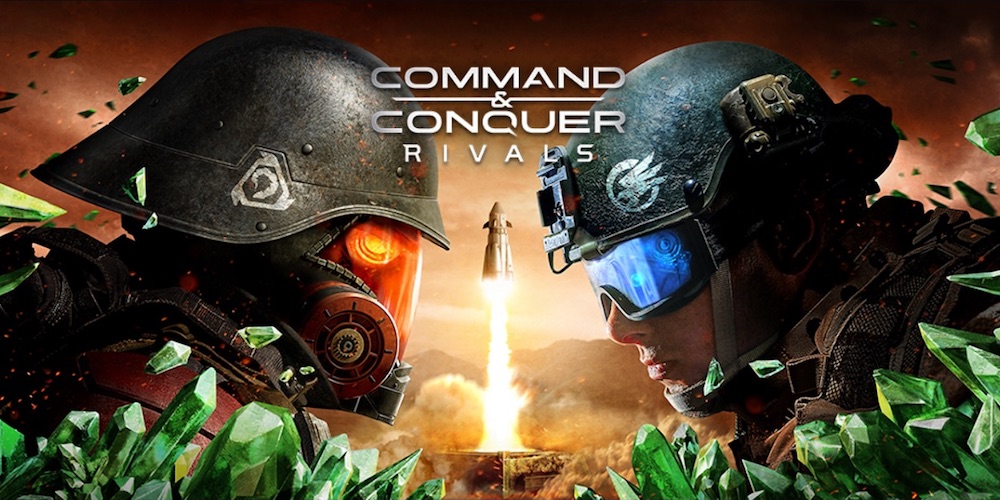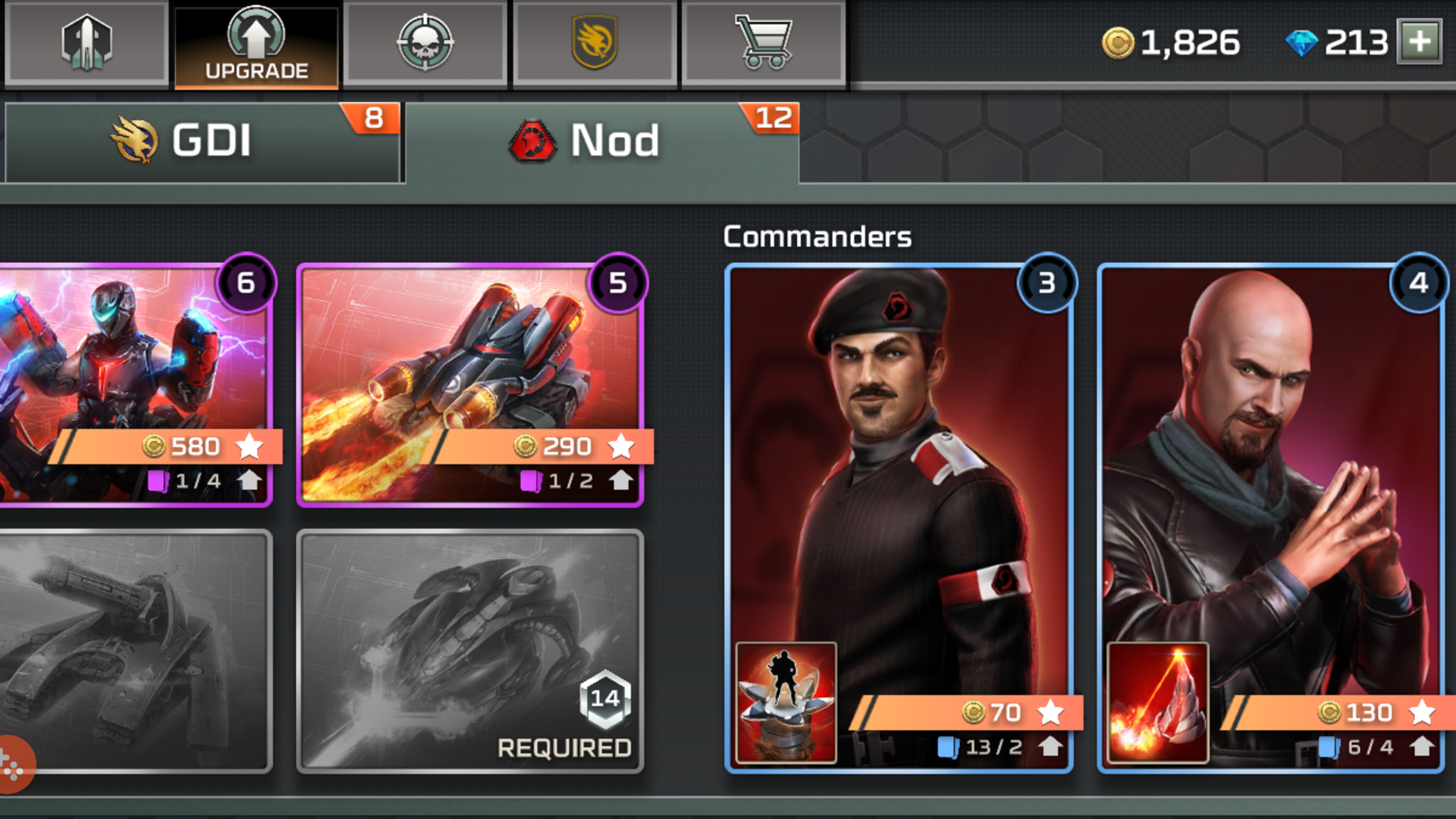
Like the rest of the internet, I was disappointed when I heard that the overdue return of Command & Conquer is a mobile game rather than a traditional PC experience. However, my frustration dwindled after I watched a full match commentary and thought it looked kinda fun. I’ve since received access to the pre-alpha and have played about 12 hours. As much as raging fans will be displeased to hear me say this, I’ve been loving it. The battles in Rivals are frantic and fast-paced, and there’s something so appealing and convenient about having an entire RTS match in only a few minutes.
Fans of Command & Conquer have different ideas of what the franchise means to them. There’s no single-player component, so Rivals will only appeal to those who enjoy multiplayer. To me, Command & Conquer is an action-focused RTS, emphasising micromanagement, aggression and countering your opponent’s unit compositions. The primary concern I had for Rivals was if it’d contain enough depth to give it the substance and longevity that I’ve had with prior Command & Conquer games, both as a player and a shoutcaster for over 400 matches of Command & Conquer: Generals. Fortunately, Rivals has a wide range of strategic depth, and the amount of counter-play between opponents keeps each match feeling fresh. There’s a lot of variety to be found with the classic strategies such as eco boom, hit and run with attack bikes, infantry spam, quick teching and so on. Interaction is the one-word answer to my “What Makes RTS Games Fun” essay series, and Rivals contains more player interaction than any RTS I’ve played.

Rivals has the units and mechanics you’d expect from a Command & Conquer game. Here you’ll find micro, scouting, harvester harassment, simplified base building, economic management, and a strong focus on unit counters. EA learned from the backlash that Command & Conquer 4 received for its removal of many of these core mechanics. Rivals maintains the pillars of RTS but simplifies and streamlines them for shorter game length, mobile devices, and accessibility for players new to RTS. Rivals feels built from the ground up to provide gameplay on a touchscreen that isn’t a hindrance, and it achieves this through good design. Rivals would not work on a controller, yet it does on mobile because the touch screen allows for rapidly selecting and issuing orders around the map. The precision of a mouse is not required as the entire game boils down to clicking on hexes.
The scale of Rivals is smaller than previous Command & Conquer games, both in unit count and map size. The whole battlefield is viewable at all times, albeit with a typical fog of war system, so players don’t have to navigate the camera while trying to control units. At each end of the map are two opposing Command Centers, and between them lies Tiberium fields, terrain to create obstacles, and unique to Rivals are the neutral Nuclear Missile Launcher and Launch Pads. Your objective is to send forces to take and hold the Launch Pads which charge up the Nuclear Missile and eventually launch it towards the enemy Commander Center. If a Command Center gets hit twice, it’s destroyed resulting in defeat. Direct attacks on the enemy base is also an option, but control of the Launch Pads decides almost all games. The launch pads ensure the action starts early and the game flows, but harassment and defence of Harvesters instigate much of the action.

The battlefields of Rivals are broken up into a small number of hex-based tiles which can only be occupied by a single unit. Units can only attack enemies in an adjacent tile, but there are many exceptions. The tile system fundamentally changes the way unit control functions, it causes unit positioning to be more deliberate than just box selecting and attack-moving like in most PC RTS. There’s a delay between moving into a new tile and attacking adjacent enemies, so there’s an inherent defender’s advantage. However, a player on the offence can create 2-on-1 flanks so a core part of Rivals is dancing units around and forcing the enemy to attack into unfavourable engagements. Players need to constantly be aware of and balance holding the Launch Pads, Harvester harassment and finding cost-efficient engagements. If there’s a cheeky flame tank around, players also have to think about not get their base burnt down.
On top of Rivals’ really fun gameplay, the soul of Command & Conquer has been captured in the presentation. The most quirky example is how each match starts with an MCV (Mobile Construction Vehicle) entering the battlefield and deploying into a Command Center. It would’ve been so much easier for them to just have the Commander Center passive and already set up, but this addition is a nice touch that I appreciate. The music and unit responses strike the same chords that you’re used to, and there are many direct carry-overs from previous games such as Riflemen doing star jumps as their idle animation. It’s clear there was a lot of love put into Rivals by a team familiar with and passionate about Command & Conquer. This praise is not something applicable to the cancelled Command & Conquer Generals 2, which many fans of the franchise resent EA for cancelling. I played the Generals 2 Alpha, and it felt like a bland, mediocre StarCraft 2 clone where Oil Derricks functioned as Vespene Gas and ramps into the main base prevented any early aggression.

One of the impressive things about Rivals is how they’ve tackled the accessibility woes of RTS; something I have written and podcasted about in detail. Rivals doesn’t compromise depth to make the game more accessible. Instead, it gradually introduces complexity over time as players level up and gain access to additional content. New players are limited to the production of only a single harvester, but upon hitting level 5, they can then produce 2. Double harvesters may sound like an unfair advantage, but it’s merely an alternative strategy. Producing a second Harvester too early can backfire as it limits your early forces and leaves you vulnerable to harassment, as well as Tiberium being a finite resource that gets depleted. As double harvesters become more prominent, or at least the possibility of it, scouting and harassment become major parts of the game, especially as the maps later unlocked contain more exposed Tiberium locations. For a new player without double Harvesters, the complexity and stress of economic management and harassment are small factors, they mainly just have to focus on taking and holding the Launch Pads.
The steep learning curve of RTS games is a factor that makes it challenging for new players, but I think it’s only a small part of the picture. Harsh learning curves are not unique to RTS and not an issue for the vastly popular MOBAs. In my estimation, the biggest cause for the niche and waning demographic of RTS is the delayed gratification and lack of feedback, both factors that Rivals address. Part of it is that Rivals makes full use of all the dopamine drips standard for progression in a free-to-play mobile game. More importantly, the game makes it very clear what you should be doing and visualising when you’re doing well and when you’re doing poorly. There are small, individual moments of success in every match that are conveyed as blatant as firing a nuclear missile at your opponents base can be. When things go badly for a new player, it’s obvious why; their Humvee got destroyed by a Tank and their Tank got blown up by a Missile Squad. Rivals is so much more than just rock-paper-scissors in real-time, but if a new player lost it’s probably because of poor use of the counter system. Losing because Tanks keep blowing up your Humvees is easy to identify and work on; the game also communicates the strengths of each unit in-game and provides detailed information out of the game. For comparison, the typical cycle for a newbie in a multiplayer RTS is sitting in-base for 10 minutes trying to work out what to do until the enemy shows up with twice as much stuff and promptly murders everything. The icing on the cake for accessibility is that ladder anxiety and the frustration from losing are greatly minimised when the average game length is only 3-4 minutes.

The elephant in the room for many is how does balance and fairness work on a free-to-play mobile game? Players receive access to additional units and commanders via randomised cards unlocked from loot boxes. Due to the random element of cards, players generally won’t have access to the same units, even if they share the same level. It may sound unfair that only your opponent can field the Elite Zone Troopers, and it may feel unfair if you throw Predator Tanks at them. However, Zone Troopers are no match for a mere 2 squads of Riflemen. There’s no ultimate unit as everything has a weakness, fielding and positioning your forces to capitalise on the counter system is vital. Unlocking new units opens up additional strategic options, as players can only choose a loadout of 6 units to field during a game out of the 20 or so available. This is another part of the game that may sound bad, but when you play, it works quite well. I enjoy the deliberation of strategy and crafting a unit composition for maximum synergy and flexibility. It’s exciting when I unlock something new and can go back to the drawing board about building my strategy. Though I’m not sure if 6 units is the magic number, the game might work better if it had 7 or 8 available. Sometimes I feel like I am missing a unit that I need, mainly because of the potency of some air units which complicates the rock-paper-scissors matchups. There are kinks to iron out and certain units that seem to overperform, but it’s indicative of the game being in pre-alpha rather than issues with the product model or general design.
Despite the stigma of a free-to-play mobile game, Rivals is a solid return to the franchise. It feels like a Command & Conquer game, and while being different in nature, it features the units, tactics, and charm you would expect from the franchise. Rivals addresses the accessibility issues that plague RTS but without compromising the complexity and skill ceiling of the genre. It may not look flattering from the outside, but I’m sure most Command & Conquer fans will enjoy it once they try it out for themselves.











